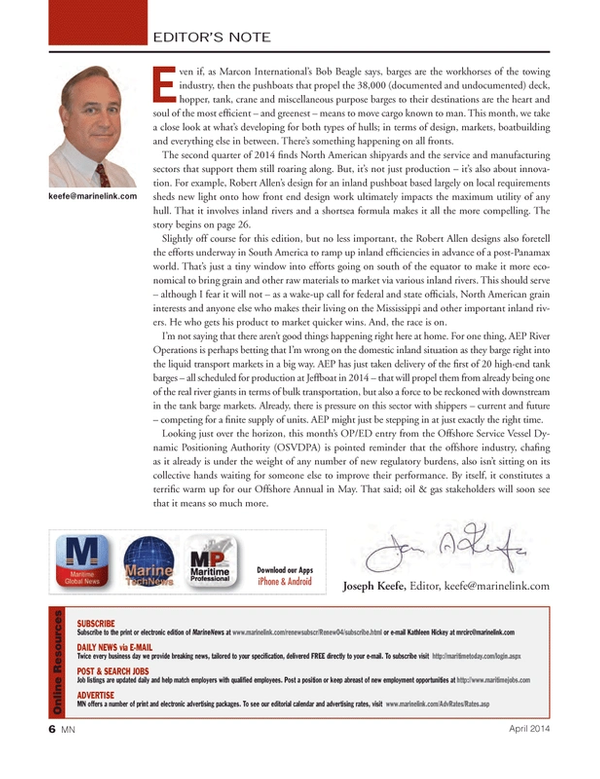
Editor's Note
Even if, as Marcon International’s Bob Beagle says, barges are the workhorses of the towing industry, then the pushboats that propel the 38,000 (documented and undocumented) deck, hopper, tank, crane and miscellaneous purpose barges to their destinations are the heart and soul of the most efficient – and greenest – means to move cargo known to man. This month, we take a close look at what’s developing for both types of hulls; in terms of design, markets, boatbuilding and everything else in between. There’s something happening on all fronts.
The second quarter of 2014 finds North American shipyards and the service and manufacturing sectors that support them still roaring along. But, it’s not just production – it’s also about innovation. For example, Robert Allen’s design for an inland pushboat based largely on local requirements sheds new light onto how front end design work ultimately impacts the maximum utility of any hull. That it involves inland rivers and a shortsea formula makes it all the more compelling. The story begins on page 26.
Slightly off course for this edition, but no less important, the Robert Allen designs also foretell the efforts underway in South America to ramp up inland efficiencies in advance of a post-Panamax world. That’s just a tiny window into efforts going on south of the equator to make it more economical to bring grain and other raw materials to market via various inland rivers. This should serve – although I fear it will not – as a wake-up call for federal and state officials, North American grain interests and anyone else who makes their living on the Mississippi and other important inland rivers. He who gets his product to market quicker wins. And, the race is on.
I’m not saying that there aren’t good things happening right here at home. For one thing, AEP River Operations is perhaps betting that I’m wrong on the domestic inland situation as they barge right into the liquid transport markets in a big way. AEP has just taken delivery of the first of 20 high-end tank barges – all scheduled for production at Jeffboat in 2014 – that will propel them from already being one of the real river giants in terms of bulk transportation, but also a force to be reckoned with downstream in the tank barge markets. Already, there is pressure on this sector with shippers – current and future – competing for a finite supply of units. AEP might just be stepping in at just exactly the right time.
Looking just over the horizon, this month’s OP/ED entry from the Offshore Service Vessel Dynamic Positioning Authority (OSVDPA) is pointed reminder that the offshore industry, chafing as it already is under the weight of any number of new regulatory burdens, also isn’t sitting on its collective hands waiting for someone else to improve their performance. By itself, it constitutes a terrific warm up for our Offshore Annual in May. That said; oil & gas stakeholders will soon see that it means so much more.
(As published in the April 2014 edition of Marine News - www.marinelink.com)
Read Editor's Note in Pdf, Flash or Html5 edition of April 2014 Marine News
Other stories from April 2014 issue
Content
- Editor's Note page: 6
- Insights - Paul Hankins, President American Salvage Association page: 12
- Boat of the Month: M/V HOS ACHIEVER page: 16
- The Offshore Service Vessel Dynamic Positioning Authority page: 20
- Oil Spill Clean Up: Your Response is Required page: 22
- Engineering Efficiency on the Paraná page: 26
- AEP Barges into the Liquid Transport Markets page: 32
- Bioremediation Goes Mainstream page: 36
- America’s First Marine Highway Comes Back to Life page: 40
- Shipbuilding: Vigor Industrial Grows Stronger page: 42
- A New Standard in Marine Communications page: 48


